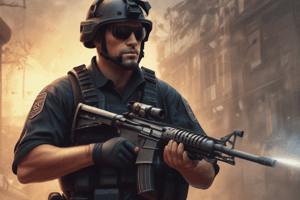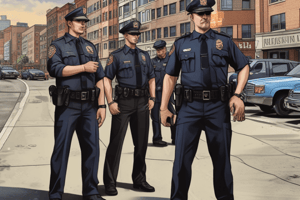Podcast
Questions and Answers
What should you do before speaking on the radio?
What should you do before speaking on the radio?
- Speak quickly
- Use personal communication
- Push-to-talk (PTT) button (correct)
- Give your location
Radio communication for security officers is not important.
Radio communication for security officers is not important.
False (B)
What tense and person should police reports be written in?
What tense and person should police reports be written in?
First person, past tense
Radio is in the ______ mode normally.
Radio is in the ______ mode normally.
What is the purpose of de-escalation techniques?
What is the purpose of de-escalation techniques?
Which statement is appropriate for report writing?
Which statement is appropriate for report writing?
Officers should presume that what makes sense to them makes sense to others.
Officers should presume that what makes sense to them makes sense to others.
What is the minimum standoff distance to react to a knife attacker?
What is the minimum standoff distance to react to a knife attacker?
What should you do if an active shooter incident occurs?
What should you do if an active shooter incident occurs?
Most active shooting incidents last longer than 15 minutes.
Most active shooting incidents last longer than 15 minutes.
What percentage of active shooters are male?
What percentage of active shooters are male?
What is the primary goal of an active shooter?
What is the primary goal of an active shooter?
The first step in responding to an active shooter situation is to _____ the situation.
The first step in responding to an active shooter situation is to _____ the situation.
Match the following actions to their corresponding responses in an active shooter situation:
Match the following actions to their corresponding responses in an active shooter situation:
What process is implemented to secure an area from a threat?
What process is implemented to secure an area from a threat?
Which of the following is NOT a method of less-lethal force?
Which of the following is NOT a method of less-lethal force?
Flashcards are hidden until you start studying
Study Notes
Introduction to Law Enforcement Training
- Training program covers levels of force, active shooter response, handcuffing, and communication protocols.
- Emphasis on continuous education and training for law enforcement personnel.
Historical Context
- Initial involvement in law enforcement began with the U.S. Navy from 1993 to 1997, followed by the Houston Police Department in 1997.
- Key events that transformed law enforcement practices include the 2001 incidents and multiple deployments to Cuba and Afghanistan.
- Houston Police Department engaged in a significant review of practices in 2018 alongside developments in school security through Conroe ISD Police Department.
Levels of Force
- Officer Presence: Non-physical deterrent aimed at resolving situations through professionalism.
- Verbalization: Officers issue clear commands to establish control without physical confrontation.
- Empty-Hand Control: Use of physical techniques such as grabs (soft) or punches (hard) to subdue individuals.
- Less-Lethal Methods: Engagement of technologies such as batons, chemical sprays, and conducted energy devices.
- Lethal Force: Authorized use of deadly weapons only when there is a serious threat to life.
Weapons of Opportunity
- Defined as improvised and accessible objects capable of stopping a threat.
- Training includes recognizing the minimum standoff distance to respond to knife attacks.
School Bomb Threats
- Bomb threats can create widespread panic and require trained staff for proper response strategies.
- Historical mishandling of threats has led to serious safety risks.
- Decision-making protocols involve assessment, searching, lockdown procedures, and evacuation strategies contingent upon threat credibility.
Active Shooter Scenarios
- An active shooter is characterized as someone attempting to kill in populated areas, often with little warning.
- 98% of incidents are single-attacker scenarios; 96% of active shooters are male.
- Connection exists between shooters and victims in 78% of cases, primarily in schools or commercial settings.
- Self-awareness and preparedness regarding workplace environments are critical for safety.
Response Strategies in an Active Shooter Situation
- Apply the OODA Loop (Observe, Orient, Decide, Act) to improve situational response.
- Run: Evacuate immediately, leaving belongings behind and seeking safe exits.
- Hide: Find secure locations, remain quiet, and silence mobile devices.
- Fight: As a last resort, use improvised weapons and coordinate actions to disorient the shooter.
- Provide essential details to law enforcement if the opportunity arises before they arrive.
Lockdown Procedures
- Lockdown aims to contain a threat through securing entrances and restricting movement.
- Clear hallways, secure doors, and shelter in place are immediate actions.
- Communication with law enforcement and following directives is essential during a lockdown.
Room Clearing Techniques
- Room clearing necessitates safety, speed, and efficiency focusing on effective team dynamics and minimizing exposure.
- Various strategies and approaches such as slicing the pie and dynamic entry enhance operational effectiveness.
- Post-clearing includes securing the environment and gathering evidence ethically.
Radio Etiquette and Report Writing
- Proper use of radios is crucial for secure communication, emphasizing clarity and conciseness.
- Radio communication should avoid private details and focus solely on situational updates.
- Security report writing follows a first-person, past tense format, and should be structured chronologically to document incidents accurately and thoroughly.
Studying That Suits You
Use AI to generate personalized quizzes and flashcards to suit your learning preferences.




